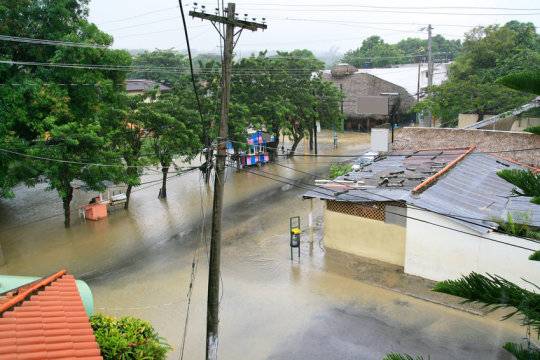[ad_1]
Failure to meet the United Nations’ 2ºC warming limits will lead to sea level rise and dire global economic consequences, new research has warned.
Published today in Environmental Research Letters, a study led by the UK National Oceanographic Centre (NOC) found flooding from rising sea levels could cost $14 trillion worldwide annually by 2100, if the target of holding global temperatures below 2ºC above pre-industrial levels is missed.
The researchers also found that upper-middle income countries such as China would see the largest increase in flood costs, whereas the highest income countries would suffer the least, thanks to existing high levels of protection infrastructure.
Dr Svetlana Jevrejeva, from the NOC, is the study’s lead author. She said: “More than 600 million people live in low-elevation coastal areas, less than 10 meters above sea level. In a warming climate, global sea level will rise due to melting of land-based glaciers and ice sheets, and from the thermal expansion of ocean waters. So, sea level rise is one of the most damaging aspects of our warming climate.”
Sea level projections exist for emissions scenarios and socio-economic scenarios. However, there are no scenarios covering limiting warming below the 2°C and 1.5°C targets during the entire 21st century and beyond.
The study team explored the pace and consequences of global and regional sea level rise with restricted warming of 1.5 ºC and 2 ºC, and compared them to sea level projections with unmitigated warming following emissions scenario Representative Concentration Pathway (RCP) 8.5.
Using World Bank income groups (high, upper middle, lower middle and low income countries), they then assessed the impact of sea level rise in coastal areas from a global perspective, and for some individual countries using the Dynamic Interactive Vulnerability Assessment modelling framework.
Dr Jevrejeva said: “We found that with a temperature rise trajectory of 1.5°C, by 2100 the median sea level will have risen by 0.52m (1.7ft). But, if the 2°C target is missed, we will see a median sea level rise of 0.86m (2.8ft), and a worst-case rise of 1.8m (5.9ft).
“If warming is not mitigated and follows the RCP8.5 sea level rise projections, the global annual flood costs without adaptation will increase to $14 trillion per year for a median sea level rise of 0.86m, and up to $27 trillion per year for 1.8m. This would account for 2.8 per cent of global GDP in 2100.”
The projected difference in coastal sea levels is also likely to mean tropical areas will see extreme sea levels more often.
“These extreme sea levels will have a negative effect on the economies of developing coastal nations, and the habitability of low-lying coastlines,” said Dr Jevrejeva. “Small, low-lying island nations such as the Maldives will be very easily affected, and the pressures on their natural resources and environmental will become even greater.
“These results place further emphasis on putting even greater efforts into mitigating rising global temperatures.”
Story Source:
Materials provided by IOP Publishing. Note: Content may be edited for style and length.
[ad_2]















